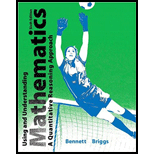
Concept explainers
Choosing the right method for finding the mean weight of apples.
Answer to Problem 1QQ
Solution:
As per definition mean is defined to be total of data points divided by number of data points.
In order to find the mean weight of apple so simply find the total weight of all the apples and divide by the number of apples. Which shows that option b is a correct answer.
Explanation of Solution
We have been given three different methods of finding the mean and we have to find the correct method the given methods are as follows.
Mean weight of apples means averaging of weights of apples, all the apples are not of same weight they vary in weight, so to find one weight that is representative of all other weights, find the weight of all the apples and divide by total number of apples and the output will be called as mean.
Formula used:
Mean =
Calculation:
For example the weight of all the apples in barrel is 42 kg and total number of apples are 400 so average (mean) weight will be
Mean = = 0.105 Kg.
Conclusion:
Mean is called an average and in order to find the mean (average) divide the total weight of data points by the total number of data point.
Want to see more full solutions like this?
Chapter 6 Solutions
USING+UNDERSTAND MATH W/MATHLABPLUS >I
- Please do not give inappropriate solutions, previous question reported, i need correct report solution for this, NO CHATGPTarrow_forwardNeed detailed report without CHATGPT, accept if you can give with code and plots, previous reported Plots are required.arrow_forwardNeed detailed report without CHATGPT, accept if you can give with code and plots, previous reportedarrow_forward
- What would you say about a set of quantitative bivariate data whose linear correlation is -1? What would a scatter diagram of the data look like? (5 points)arrow_forward1. Which set of parametric equations is shown in the graph below? Explain your reasoning. a) x = t; y = t² b) x = = t²; y = t -3-2-1 5 4 3 2 1 12 3 2. Using the graph of f, a. determine whether dy/dt is positive or negative given that dx/dt is negative and b. determine whether dx/dt is positive or negative given that dy/dt is positive. Explain your reasoning. 2 f x 1 2 3 4arrow_forwardFind the perimeter of the triangle. Express the perimeter using the same unit of measure that appears on the given sides. 9 ft 13 ft 6 ft The perimeter isarrow_forward
- Use the formula for Pr to evaluate the following expression. 9P5 9P5 =☐arrow_forwardFind the volume of the figure. The volume of the figure is 3 m 3 m 3 marrow_forwardFind the circumference and area of the circle. Express answers in terms of and then round to the nearest tenth. Find the circumference in terms of C= (Type an exact answer in terms of x.) Find the circumference rounded to the nearest tenth. C= Find the area in terms of A= (Type an exact answer in terms of x.) Find the area rounded to the nearest tenth. A= 10 cmarrow_forward
- Sox & Sin (px) dx 0arrow_forwardIn Exercises 62-64, sketch a reasonable graph that models the given situation. The number of hours of daylight per day in your hometown over a two-year period The motion of a diving board vibrating 10 inches in each direction per second just after someone has dived off The distance of a rotating beam of light from a point on a wallarrow_forward8 L 8 e ipx dxarrow_forward
 Discrete Mathematics and Its Applications ( 8th I...MathISBN:9781259676512Author:Kenneth H RosenPublisher:McGraw-Hill Education
Discrete Mathematics and Its Applications ( 8th I...MathISBN:9781259676512Author:Kenneth H RosenPublisher:McGraw-Hill Education Mathematics for Elementary Teachers with Activiti...MathISBN:9780134392790Author:Beckmann, SybillaPublisher:PEARSON
Mathematics for Elementary Teachers with Activiti...MathISBN:9780134392790Author:Beckmann, SybillaPublisher:PEARSON
 Thinking Mathematically (7th Edition)MathISBN:9780134683713Author:Robert F. BlitzerPublisher:PEARSON
Thinking Mathematically (7th Edition)MathISBN:9780134683713Author:Robert F. BlitzerPublisher:PEARSON Discrete Mathematics With ApplicationsMathISBN:9781337694193Author:EPP, Susanna S.Publisher:Cengage Learning,
Discrete Mathematics With ApplicationsMathISBN:9781337694193Author:EPP, Susanna S.Publisher:Cengage Learning, Pathways To Math Literacy (looseleaf)MathISBN:9781259985607Author:David Sobecki Professor, Brian A. MercerPublisher:McGraw-Hill Education
Pathways To Math Literacy (looseleaf)MathISBN:9781259985607Author:David Sobecki Professor, Brian A. MercerPublisher:McGraw-Hill Education





